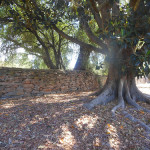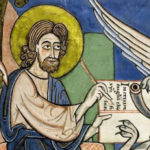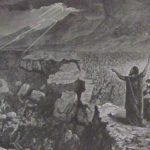We run our website the way we wished the whole internet worked: we provide high quality original content with no ads. We are funded solely by your direct support. Please consider supporting this project.

How to Interpret the Law of the Old Testament
While there are multitudes of passages in the OT that reflect an awareness that people are too sinful to be rightly related to God on the basis of the law, there is a strand that runs throughout the OT that depicts Yahweh as “law-oriented.” This label is warranted, I believe, in light of the fact that the OT seems to assume that an individual’s and group’s relationship with God is rooted in, and dependent upon, their compliance with the law.
This law-orientation is evident in the sheer number of laws as well as the remarkable specificity of the laws Yahweh is portrayed as giving his people. There are, in fact, 613 distinct laws in the OT. Of course, many of these laws reflect wise and humane principles about how we should honor God, treat other humans and care for animals and the land. Other laws, however, are not so easily understood. For example, in Leviticus 19:19 the Lord “decrees” prohibitions against crossbreeding animals, growing different kinds of crops in the same field and wearing clothing made from different kinds of fabrics! Some sense can be made of this prohibition when we consider the obsession with distinctions and boundaries that characterizes the priestly code. Yet, from a theological perspective, it’s not altogether clear why the Creator would care about such matters.
Even more puzzling, and undoubtedly more offensive today, is the portrait of Yahweh telling Aaron that “[f]or generations to come” no one with a “a defect” is permitted to make an offering in the temple.” Among those excluded by this law was anyone “who is blind or lame, disfigured or deformed,” anyone “with a crippled foot or hand or who is a hunchback or a dwarf,” as well as anyone “who has any eye defect, or who has festering or running sores or damaged testicles” (Lev. 21:17-20). The passage concludes by depicting the Lord as declaring that allowing such people to “go near the curtain or approach the altar” would “desecrate my sanctuary” (Lev. 21:23). The text offers no explanation as to why the presence of physically imperfect people “desecrates” the Lord’s sanctuary. What is clear, however, is that this is a portrait of a God who does not want to be associated with imperfections and who is very concerned with very specific laws. In this light, it does not seem unfair to describe portraits of God like this to be “law-oriented.”
In addition, the law prescribes many shockingly harsh consequences for those who violate these laws. For example, a couple that had sexual relations with one another while the wife was menstruating were to be forever banished from Israel (Lev. 20:18). Understood in its context where individuals were defined by their belonging to a particular community, this punishment is almost equivalent to a death sentence. On top of this, capital punishment was prescribed for a variety of infractions, some of which seem relatively minor, such as cursing or striking one’s parents (Ex. 21:15, 17; Lev. 20:9), or being a “stubborn” or “rebellious” son (Deut. 21:18-21).
It’s my contention that this law-oriented portrait of God in the OT does not reflect what God is really like. This portrait rather reflects a fallen, culturally conditioned framework that God, as a heavenly missionary, humbly embodied himself within as a means of staying in a redemptive relationship with his rebellious people while continuing to further his redemptive plans for the world through them. It was, in short, a mask that God put on.
There are a multitude of indications in the biblical narrative that point toward the conciliatory nature of this strand of the OT. Most importantly, the law-oriented portrait of God scarcely resembles the portrait of God revealed in Christ. While Jesus certainly believed the law was divinely inspired, and while his life generally complied with the law, it’s also clear that Jesus didn’t submit to the law in a rigid manner. For example, Jesus had the audacity to replace the OT’s lex talionis with his radical teaching about loving enemies and about nonviolence (Mt 5:41ff). Since Jesus reveals the true character and will of God, this alteration of a foundational aspect of the OT should itself be enough to demonstrate that God was stooping to accommodate the sinful condition of his people when he appropriated the “eye for an eye” and “tooth for a tooth” command as his own.
On top of this, consider the remarkable contrast between Jesus’ attitude toward people with defects and the attitude expressed in the above mentioned OT law declaring that such people ‘desecrate” God’s temple. The One in whom God actually “tabernacled” among humans (Jn 1:14) regularly fellowshipped with and ministered to people who were defective by OT standards. He seems to have had no trouble violating OT laws and breaking social taboos by touching lepers. And he took no offense when a woman who suffered from a chronic bleeding disorder blatantly violated OT protocol by touching him.
While such people could not approach God in the OT, in Jesus, God approaches them. Indeed, it’s significant that while Jesus gravitated toward people judged to be defective and “unclean” by the law, he reserves his harshest words toward those “righteous” people who tried most earnestly to live by it. Since Jesus reveals what God is truly like, we must, I submit, conclude that the OT portrait of a law-oriented deity who pronounced certain people defective and “unclean” does not reflect who God truly is. What it reveals, rather, is how low God was willing to stoop to remain in a redemptive relationship with his people and to continue to further his sovereign purposes through them.
Image by Alice Hampson
Category: General
Tags: Cruciform Theology, God, Jesus, Law, Old Testament
Topics: Attributes and Character, Biblical Interpretation
Related Reading

Why Did Jesus Curse the Fig Tree?
One of the strangest episodes recorded in the Gospels is Jesus cursing a fig tree because he was hungry and it didn’t have any figs (Mk 11:12-14; Mt 21:18-19). It’s the only destructive miracle found in the New Testament. What’s particularly puzzling is that Mark tells us the reason the fig tree had no figs…

If Jesus Is the Whole Point, Then What’s the Point of the Old Testament? (podcast)
Greg considers the role of the Old Testament in Christian faith. Episode 554 http://traffic.libsyn.com/askgregboyd/Episode_0554.mp3

Podcast: Does a Jesus-Centric Theology Reduce God?
Greg challenges the traditional starting point of many theologies and defends starting our theology about God’s nature and character with what has been revealed about Jesus. http://traffic.libsyn.com/askgregboyd/Episode_0325.mp3

How To Fix The Church: The Kingdom of God (Part 4)
God has leveraged everything on the Church loving like Jesus loved, as outlined in our previous posts in this series. “By this the world will know you are my disciples,” Jesus said, “by your love” (Jn 13:35). By God’s own design, Christ-like love is supposed to be the proof that Jesus is real. In John…

What do you think of Thomas Aquinas’ view of God?
Question: You have written (in Trinity and Process) that the relational God of the Bible is the antithesis of the immutable God of Thomas Aquinas. Could you explain this? Answer: Aquinas and much of the classical theological tradition borrowed heavily from Aristotle’s notion of God as an “unmoved mover.” God moves the world but remains…

Four Principles of the Cruciform Thesis
In the second volume of Crucifixion of the Warrior God, I introduce how four dimensions of the revelation of God on the cross (as introduced in this post) lead to four principles that show us how to unlock aspects of the OT’s violent divine portraits and thus disclose how a given portrait bears witness to…
